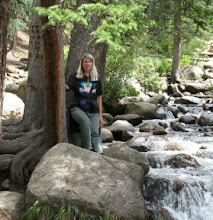 This morning, a snowy spring equinox, she has a name. She has been here long enough to become familiar, a person in her own right, not just “the sharp-shinned hawk” but now labeled Artemis. (We considered Kali, the Hindu goddess of death, but settled on the Huntress, death on the wing.) We know it’s nothing more than convenience, a shorthand for talking about her and what she’s doing. She has no love for us (though we love watching her), only for our birdfeeders and the happy habitat they have created. Our long habit of putting out birdseed is paying off for this young hawk, as she learns her trade and practices her skills. Her habitual presence is bringing a dynamic new level of meaning to the phrase "birdfeeder."
This morning, a snowy spring equinox, she has a name. She has been here long enough to become familiar, a person in her own right, not just “the sharp-shinned hawk” but now labeled Artemis. (We considered Kali, the Hindu goddess of death, but settled on the Huntress, death on the wing.) We know it’s nothing more than convenience, a shorthand for talking about her and what she’s doing. She has no love for us (though we love watching her), only for our birdfeeders and the happy habitat they have created. Our long habit of putting out birdseed is paying off for this young hawk, as she learns her trade and practices her skills. Her habitual presence is bringing a dynamic new level of meaning to the phrase "birdfeeder."Her first catch that we observed was a starling. Finally, an antidote for starlings! Nasty, dirty, and numerous, they descend en masse and consume bushels of birdseed and chicken feed. They’ve even taken to roosting in the coop on cold days. After she devoured one under the lilac, I didn’t see another in the yard for three days. They eventually returned; then she ate one on the front patio, leaving only feathers and blood on the snow. One day, scanning for her, I spotted her high in the elm tree—her first (to our knowledge) aerial meal.
Last week, returning home in the late afternoon, I saw her in the driveway with another starling, still struggling. I stopped, sat in the car watching, as she pounced with it, slamming it into the ground, pecking at it, trying to complete the kill. At last she settled down to eat. It’s labor intensive; takes a long time to eat a starling (assuming you have the stomach for it). For an hour she tore at it, tiny piece by piece, ripping and swallowing. It was cold. I finally decided I could go the last twenty yards home without making her give up her kill. I slowly crept forward, still in the car, until she bolted—taking the remains of her meal along.
So today there are no starlings to choose from: it will have to be a junco or sparrow, maybe even a towhee, who slips up, lets hunger overcome caution. After more than two hours, she’s losing patience. The forays are more frequent; she flies east to the apple tree, as a dozen juncos immediately fly west. She swoops low around the apple tree, hops on the fenceposts, trying to flush one into the open. The melodrama is not without humor, at least for the observer. The little birds are teasing her now; she’s going to walk into that bush to get them.
Suddenly she’s gone, I can’t spot her anywhere. Dozens of juncos and sparrows hit the birdfeeders. Somewhere, I suspect, breakfast is served.

No comments:
Post a Comment